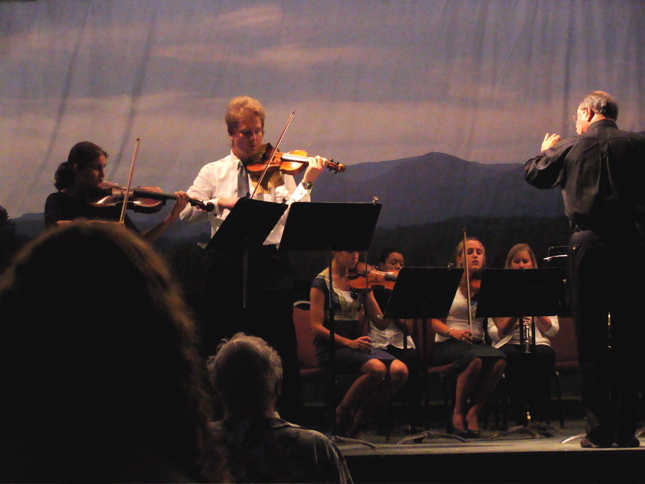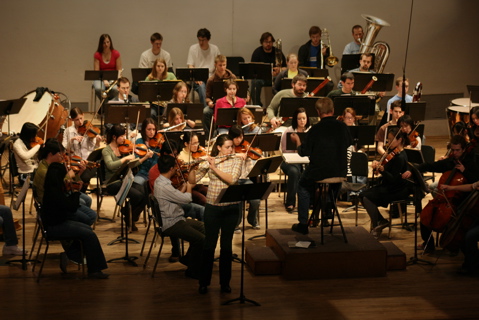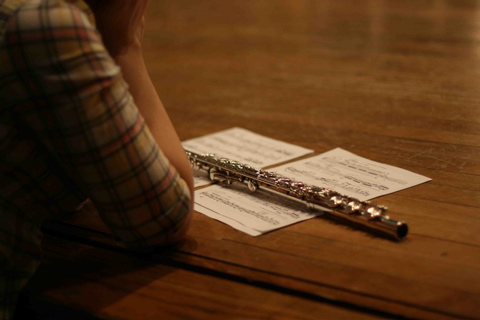Large Ensemble Works
- Concerto for Trombone and Orchestra "Cowiche"
- From Sabres to Satellites
- ...but in this dark night I am stationary and time is a river: The Diary of Agnes Williams
- What we talk about when we talk in 140 characters
- Icarus
- Yet what is any ocean but a multitude of drops?
- fragments and memories
- The Invisible Magic Soccer Phone
- I.Jest
- Concertino for Vln and Vla
- Concerto for Flute
- Rhapsody for Dean Moriarty
Concerto for Trombone and Orchestra
"Cowiche"
for solo trombone and orchestra
This concerto was originally composed in late 2004, early 2005. I wrote it for the Cowiche Conservancy, a group that raises awareness and maintains the Cowiche Canyon, a desert landscape in Yakima, Washington (where I’m originally from). The work was never premiered in its initial form, and in 2006 I adapted it with a little revision for Trombone and Piano. The work finally was premiered and got a few performances in 2006/2007, but always the trombone/piano version. In 2016 I began talks with Matthew Russo to perform one of my trombone and orchestra works with the University of Connecticut Orchestra. I went back to this work and decided that it deserved a full-ensemble representation, but not as originally written (10-years-ago Ryan was not a great orchestrator). I started from the Trombone/Piano version and orchestrated largely from scratch, although certain sections were brought in relatively unscathed. So, what you have is an amalgam, a work that combines music I have written over a decade apart into a finally fully-realized trombone concerto.
And here, from the original work is the program note: The “Cowiche” Concerto is intended as a journey for the trombone. The music is held coherent throughout using a five-note idée fixe that is developed and manipulated into the majority of the material presented. Although formally broken into three movements, the music occurs continuously, with no break between movements. In this way, the music is able to change drastically, yet retain a feeling of movement. This gives the solo a wandering feeling, as if the trombone is a hiker trekking through the Cowiche canyon.
To be premiered by Matthew Russo and the UCONN Symphony Orchestra on March 9th, 2017 at UCONN Storrs.
From Sabres to Satellites
for wind band
From Sabres to Satellites was commissioned by the US Army MI Corps Band.
The title of the piece is also the motto of the base for the Army MI Corps Band, Fort Huachuca. This motto brings up a lot of thoughts about the history of military intelligence. I thought of secret messages smuggled from Hercules Mulligan to George Washington, the importance of unbreakable codes during WWII, and the need for even better codes for our digital present. I also was thinking back to the great military bands, including the Glen Miller Band during WWII.
This piece relies heavily on my background in jazz, but is also constructed in a modern-classical style. The opening trumpet motif builds the entire piece. It’s just not until much later that you realize it comes from a run-of-the-mill jazz tune. But in- between the slow open and the big band finish the motif drives everything, including a melody that can’t decide if it is a waltz or in 4/4.
Premiered by The US Army MI Corps Band on October 1st, 2016 in Arizona.
...but in this dark night I am stationary and time is a river: The Diary of Agnes Williams
for soprano and chamber orchestra
Duration - approximately 30 minutes
Program Notes:
...but in this dark night... was commissioned by the Hartford Independent Chamber Orchestra with generous support from the City of Hartford Arts & Heritage Jobs Grant Program and written for Elisabeth Halliday-Quan. Both Elisabeth and Dan D’Addio were instrumental in helping me realize this work.
What you are about to hear could, I guess, be called an opera. But if it is an opera then it is one set in no place (and all places) occurring in no time (yet all time). Agnes, our soprano, has found herself “unstuck” in time. How this happened seems to elude her, but she does remember an airplane flying overhead on her 10th birthday, and by the time she had jumped out of the tree to go inside for dinner she was no longer home.
What Agnes doesn’t know is that the airplane is United Airlines flight 173, and the date is December 28th, 1978. UA 173 is going to crash in the small suburb. As Agnes jumps from the tree she finds herself no longer living a linear life, but rather spiraling through time and space, infinitely circling a few specific times and places.
Princeton – 1949 – Agnes walks with Einstein and Gödel across the campus. They talk and she listens.
San Francisco – 1968 – Agnes is with her own mother on the day of her birth. She helps her as her father is off fetching The Doctor.
Portland – 1978 – Agnes is in the tree, and although she has been here so many times before, she always jumps, starting the cycle over again.
New York – 1999 – Agnes walks in Times Square days before the start of the new millennium.
Utah – 2001 – Agnes stands on the edge of a cliff looking out at sunset. She sees the reflection of the town floating in the sky. As the sun sets she returns to the empty house and watches the news.
Why she keeps returning to those places is a mystery, but she has done it for what seems like eons. While unstuck she has aged, learned, changed, yet remained exactly the same. She wants it to stop, but can’t see a way out. As she constantly returns to her mother on the day of her birth she fears there might only be one way to escape.
Premiered by Elisabeth Halliday and the Hartford Independent Chamber Orchestra on Oct. 10th, 2015 in Hartford, CT
What we talk about when we talk in 140 characters
for chamber orchestra
I – Click Bait
II – Emoji
III – an unchecked fact
IV – What's in a meme?
V – H8ers will H8
Total Duration - approx. 9 minutes
Program Notes:
What we talk about when we talk in 140 characters is a mash-up of an old minimalist master and the new—Raymond Carver and Twitter. Like Twitter, I wanted to try and challenge myself by limiting the length of each movement, in this case, to 140 seconds. And for each movement I wanted to encapsulate one of the many styles that these short messages often take.
The first movement, Click Bait, is named after the titillating titles that you find on Twitter from the likes of Upworthy and Buzzfeed. The second, Emoji, is named after these little pictures that don’t really know how to use, but I see all the time...The third movement, an unchecked fact, acknowledges the harm that Twitter can do when rumors and unchecked news spread faster than it can be contained. The fourth, What’s in a meme?, is all about the plethora of memes spinning around and around again. And the final movement, H8ers will H8, has a little fun at the expense of the numerous internet trolls that trounce upon people they disagree with, and the people who are so insulated that no manner of truth can penetrate.
But mostly, this is just a fun piece where I explored an idea for 140 seconds and then move on to the next, just like I do everyday while going through my Twitter feed...
Enjoy!
To be premiered by the Hartford Independent Chamber Orchestra on Dec. 6th, 2014 in Hartford, CT
Icarus
for flute and wind band
Duration - approx.16 minutes
an orchestrated version of Icarus for alto saxophone and piano. To be premiered by a flutist, but written for either flute or alto sax
To be premiered in Santa Rosa, CA in October 2013
Yet what is any ocean but a multitude of drops?
for wind ensemble
Duration - approx.12 minutes
Program Notes:
Yet what is any ocean but a multitude of drops? is the last line from David Mitchell’s Cloud Atlas, and like the novel, this work has a distinct form. The music develops in several different styles and worlds until about halfway through, then retrogrades itself for the latter half of the work. Although tempting, there are no literal depictions in the work, and the only programmatic element is the form. The music resolves around a minor third, which figures prominently in all the melodies and motives.
I began the work in late 2012 as if by magic (having read the book and seen the film of Cloud Atlas, it would seem poetic to believe the music just came into existence, but alas, this is my normal process). I had wanted to write a work for wind ensemble that did not feature a soloist (a previous work had proven problematic to program due to the necessity of a soloist) and almost immediately, the Cloud Atlas idea seemed a perfect way to structure a work. The trick I found was of course not to simply repeat, but to develop, as if the work in reverse was unfolding in the same natural way that it had done in the first half.
The work was primarily completed during the Thanksgiving season, much of it at my inlaws during a nice break from the day job. Sitting by the fire in Maine and writing music is a very nice way to spend a holiday, and I hope the work sparkles with the warmth and possibilities that surrounded me during that time.
Premiered on April 30th, 2016 by John Hart and the Hartt Wind Ensemble.
fragments and memories
{Concerto for Trombone}
for trombone and orchestra
(originally written for trombone and piano)
available for purchase from Warwick Music
duration app. 14 min. (piano version);
17 min. (orchestrated version)
Program Notes:
fragments and memories was written for Radu Clipa, an extremely talented trombonist living in Bucharest, Romania, who also gave the international premiere of my Trombone Sonata.
fragments and memories is built upon a few basic motives. The first is a series of repeated notes that then leaps up a sixth and then back down, ending a semitone above or below the initial note. The second is a fast moving passage that eventually rests on neighbor-note figure.. From there, the trombone and piano take off in a flight of fancy, and the motives follow, changing and transforming throughout. The piece is in three larger sections, but within each section the music flows naturally, making references to things that have come before, or will be yet to come. How all of this comes together to make a coherent piece is for theorists to decode. For the listener, I strove to create easy to follow connections, and a motivic saturation that is never stagnant or boring. The title is not a reference to the form or construction, but rather an evocative title as to how the listener might come to understand the piece. My intention was to write a piece that would be fun to play, and hopefully also fun to hear.
The current version of the piece was written for trombone and piano, but throughout, my compositional intent was to write with a larger ensemble in mind. Still I wanted the piece to remain “pianistic”. Hopefully the result is a piece that sounds natural on the piano, but also infuses the listener’s imagination with possible orchestral colors and gestures.
-Ryan Jesperson
10/7/2008
this work was written for Radu Clipa and was premiered in Bucharest, Romania on Jan 21st, 2009. It will also be performed as part of the CMU New Music Festival in March, 2009, and is the winner of the 2008/2009 British Trombone Society Composition Contest. Jordan Jacobson and HICO will premiere the orchestra version on April 20th and 22nd, 2013.

Amanda Arrington and Tremon Kizer
The Invisible Magic Soccer Phone
for band
duration app. 6 min.
Program Notes:
This work was commissioned by Tim Fisher and the Memorial Middle School Band. It was written with their help and inspiration.
North Korea sent a soccer team to the 2010 World Cup. During the tournament I read a newspaper article in which the North Korean coach told the media that their leader, Kim Jong Il, had invented an invisible cell phone that allowed him to be in constant contact with the coach, calling plays, devising stratagems, etc...Around the same time, I was talking with Tim about writing something for his ensemble. As I was writing the work I found that the programmatic elements really defined the piece. The glockenspiel constantly chirps its “cell phone” ring as the rest of the instruments go about their business, and eventually the music builds into a military-like quality as if depicting a practice for the squad. Then, the music breaks down and the “game” begins. The vuvuzelas are present as are random cheers and even refs handing out yellow cards. The music and the game grows to a fever-pitch, then there’s a goal. The piece ends shortly thereafter, because, as we know, one goal is generally good enough for a soccer match.
So the piece was nearly finished when Tim brought me an interesting piece of news. The principal of his school had read an article in the paper where Kim Jong Il, the notorious cell phone inventor, publicly claimed that North Korea in fact did not send a team to the World Cup, and the team that finished in last place in the tournament were imposters from the West.
Enjoy the piece, unless of course Kim Jong Il has invented invisible ear muffs and placed them over your ears, in which case we should all be worried...
Ryan Jesperson
1/22/2011
The Invisible Magic Soccer Phone will be premiered by Memorial Middle School in the spring of 2011.
I. Jest
for orchestra
Duration: 10 min.
Program Notes:
I. Jest started its life as an orchestration experiment. I was listening to a work that had one of those stacked chord build-ups, you know, when each instrument comes in on a different beat, sustaining his/her pitch and creating a big swell. Well, I was listening to a piece with a lot of those in it and I got the idea to try and do it in reverse, start with the big mass and then accent each note as it exits until only a single pitch remains. Not only that, but I thought it might be fun to try and use some serialist procedures in the piece (it’s painful to admit, but we all sometimes have such urges)…
Well, that lasted all of five minutes or so before I abandoned any serialist methodology and took the opening gesture and ran with it. The programmatic elements were introduced when I restarted the piece in the fall of 2009 (I had written about twenty measures during the summer and then shelved it), and I use the book Infinite Jest as a sort of metaphorical model. I wanted this piece to have a few drastically different kinds of music (like the staticness of Marathe and Steeply talking on the mesa in New Mexico, or the frenetic energy of an ETA tennis match, or the anguish and inherent sadness of the Ennet House residents). I desired to write a piece that was able to jump quickly and unabashedly from a high-minded modernist approach to a groove and back, becoming entirely post-modern in the process. I also wanted to bring about the mental anguish of the sought-after “entertainment” with a raucous shout section, where the music doesn’t as much go in your ears as punch a hole through your skull and lounge about in your brain. But I wanted to do all this under the auspices of believable music. That is, I didn’t want you to have to read the book to understand the music. It’s not that kind of programmatic crap.
No, my friends, this is just an orchestra piece that I had a lot of fun writing, and I hope you have a lot of fun experiencing.
Ryan Jesperson
transcribed via interlace viewer
Nov. 16th, Year of the Depend Adult Undergarment
I. Jest won the 2010 UMKC Orchestra Competition and will be premiered by Robert Olson and the UMKC Orchestra Feb. 25th, 2011.
Concertino for Violin and Viola
for solo violin and viola, with fl, cl, hrn, 2 vlns, vla, vc, and cb.
duration: appr. 10 min.
Program Notes:
Concertino for Violin and Viola was written for the participants of the 2008 Wintergreen Academy in Wintergreen, Virginia. The piece is for 2 soloists and an “orchestra” of 8 other players.
The work is divided into three large sections, each of which is separated into a multitude of smaller segments. The musical material is derived from the opening gestures in the “orchestra” part and the first entrance of the soloists. Throughout the work the material is transformed using timbral and motivic development. Basically all the standard 21st century musical stuff… The intention of the piece was to write something that would be enjoyable for 10 minutes, and if that happens, why should it matter how it was created? But now you know, and hopefully that will help you untangle the “mystery” of modern music and this piece in particular. And that’s all I could hope for, right?
Enjoy.
-Ryan Jesperson
June 23rd, 2008
Concertino for Violin and Viola was premiered on July 22nd, 2008 in Wintergreen, VA as part of the Wintergreen Academy Composer's Concert. Nicholas Szucs, vln and Anne Lanzilotti, vla were the soloists and Jim Glazebrook conducted.
 Anne Lanzilotti and Nicholas Szuchs, soloists. Jim Glazebrook, conductor. |
 Jim Glazebrook conducting the orchestra: Ashley Porter - fl |

The Dress Rehearsal
Concerto for Flute
"Icarus"
for flute and large orchestra
Duration - approx. 20 min.
Program Notes:
Concerto for Flute was written for and with the assistance of Sophia Tegart.
Ovid wrote, “And all look up, in absolute amazement,/At those air-borne above. They must be gods!” Concerto for Flute did not begin attached to the myth of Icarus and his father Daedalus. It began as a concerto for Sophia Tegart, a piece to showcase her incredible ability and facility on the flute. Slowly, Concerto for Flute developed into a three movement battle between the flute and the orchestra, sometimes the flute leading, sometimes the orchestra. Still, it did not have any programmatic elements and I wasn’t initially sure I wanted any.
Then it came time to name the piece…
I wanted it to have a subtitle, so it wouldn’t just be a “concerto for flute”. That was when I started analyzing the character of the piece and what it wanted to say. The end was very tragic, with the flute losing the battle and being swallowed up by the orchestra. An ending like that seemed ideal for Greek or Roman tragedy. Shortly thereafter I came up with the idea of “Icarus”. Indeed, the flute feels to be a kindred spirit to the young boy, full of mirth, wonderment and even hubris. After rereading Ovid, I decided upon the following tale for the concerto. Of course, certain skeptics might scoff at the idea of programmatic elements added after the composition has been completed. If you feel this way, then by all means disregard the programmatic elements. For those that need some sort of story to become engaged in the work, here it is. Enjoy.
I – Taking Flight: The first movement envisions Daedalus creating the wings and teaching his son to fly. Like a baby bird, Icarus has many failed attempts before finally feeling comfortable. The movement ends with Icarus being warned not to fly too close to the sun, but nonetheless soaring high above his father
II – Among the Gods: Icarus and Daedalus are flying toward freedom and home. It is from below that we view them, above us like Gods, soaring over the farmers, fishermen and shepherds. They swoop and dive, veer and glide, chasing birds and skimming the water. Icarus feels the salty air and the joy of flight.
III – Melting Wax: The hubris of flight has blinded the boy to his father’s warning. Icarus flies higher and higher, making dangerously fast turns and maneuvers. He continues upward until he is gazing at the clouds below. That is when the wings begin to break apart. He desperately tries to keep it together, but is unable. He is now waving featherless wings wildly, falling toward the sea. Icarus reaches out to his father but it is too late: the boy has been swallowed by the sea.
the second movement has been recorded by Sophia Tegart and Kairy Koshoeva on May 14th in Kansas City, MO.
The third movement was premiered on Feb. 25th, 2009 by Sophia Tegart and the UMKC Orchestra in Kansas City, MO.
The second movement was read on March 13th, 2009 by Sophia Tegart and the UMKC Orchestra in Kansas City, MO.
Photos from the dress rehearsal
(photos by Richard Johnson)




Rhapsody for Dean Moriarty
for alto saxophone and jazz orchestra (5 sxs, 4tpts, 4tbns, 2 vlns, vla, vc, pno, bass and drum set)
Duration - approximately 22 minutes
Program Notes:
Rhapsody for Dean Moriarty is a concerto for alto saxophone and jazz orchestra that draws inspiration from the character of the same name in Jack Kerouac’s On The Road. The title is both a tribute to Kerouac’s distinctive “bebop” writing style, as well as the piece that “made a lady out of jazz”, Gershwin’s concert masterpiece Rhapsody in Blue.
Rhapsody for Dean Moriarty is infused with Dean’s manic intensity and affection for long-blowing bebop solos. With extended solis and a lot of improvisation Rhapsody creates its own frenetic pace, spinning in circles rubbing its belly like a beatnik in a jazz club. For this the alto sax part is key, as the soloist is entrusted to take the motives and riffs from the written parts and develop them through improvisation into something new and fresh. Often, the improvisation is added in addition to written material, inviting the soloist to “comment” or respond to what the other instruments are playing. The melodic material presented throughout the piece can also be thought of in terms of improvisation, since many of the phrases are reused throughout in different ways, in addition to the tendency of introducing new melodies over previously used chord progressions. Rhapsody is always moving and changing, and the listener should find it both invigorating and taxing to keep up.
Although performed without pause, the piece is nonetheless divided into three formal movements, with a quote from On The Road beginning each.
I.
…raised his horn and blew into it quietly and thoughtfully and elicited birdlike phrases and architectural Miles Davis logics. These were the children of the great bop innovators...
II.
...always wanted to reach, which was the complete step across chronological time into timeless shadows, and wonderment in the bleakness of the mortal realm, and the sensation...
III.
...that gloomy, saintly goof in whom the history of jazz was wrapped; for when he held his horn high and horizontal from his mouth he blew the greatest...
Portions of this piece were read by the Hartt Big Band in Dec. 2006, with Jeff Welsh playing the alto sax solo. Rhapsody for Dean Moriarty was revised in the spring of 2010 and will be premiered in a future season by Bobby Watson and the UMKC Big Band. Bobby will be playing the solo part.


